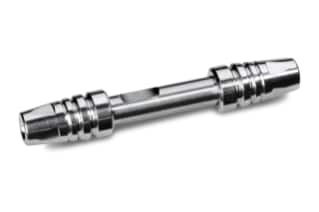
|
Chemistry |
2-Ethylpyridine |
|
Separation Mode |
SuperCritical Fluid (SFC) |
|
Particle Substrate |
Hybrid |
|
Maximum Pressure |
6000 psi (415 Bar) |
|
Endcapped |
No |
|
Silanol Activity |
Medium |
|
Particle Shape |
Spherical |
|
Particle Size |
1.7 µm |
|
Endfitting Type |
Parker-style |
|
Pore Size |
130 Å |
|
Format |
Column |
|
Surface Area |
185 |
|
System |
UPC2, SFC |
|
Particle Technology |
BEH |
|
Technique |
SFC, SFC/MS |
|
Inner Diameter |
3 mm |
|
Length |
75 mm |
|
Carbon Load |
9 % |
|
eCord |
Yes |
|
UNSPSC |
41115711 |
|
Brand |
Viridis |
|
Product Type |
Columns |
|
Units per Package |
1 pk |

Viridis BEH 2-Ethylpyridine Column, 130Å, 1.7 µm, 3 mm X 75 mm, 1/pk
Viridis Columns add achiral SuperCritical Fluid (SFC) selectivities to the mixture. High-Strength Silica, Charged Surface Hybrid, and Ethylene Bridged Hybrid (BEH) are some of the particle technologies utilized in these columns (HSS). Based on BEH, the lab equipment is described below. Unusual peak geometries are created, notably for well-retained basic achiral chemicals, when surface silanol activity on Viridis particles is decreased or altered under SuperCritical Fluid (SFC) conditions.
Viridis Supercritical Fluid Chromatography (SFC) columns introduce a new degree of reproducibility to the field of laboratory scale purification by integrating cutting-edge media creation with market-leading column technology. The sub-2-m and 3.5-m columns from Viridis, which were developed and tested for the ACQUITY UPC2 system, show exceptional efficacy and resolution. Without the use of mobile-phase additives, Viridis particles' surface silanol activity can be reduced and controlled to generate attractive peak morphologies even for well-retained basic achiral compounds.
Similar to other Waters gear, these columns are built in specialized Waters facilities. All Water factories and facilities follow the most stringent cGMP and ISO 9001 guidelines. To guarantee that the lab equipment you use is of the highest standard, the production process is painstakingly examined and tracked. This provides all our clients with mental satisfaction that they can expect their lab equipment to behave as intended.
You can shop for lab equipment, update your inventory, and diversify your present equipment portfolio by visiting our website and browsing our catalog. You can contact a member of our staff at one of our overseas locations with questions or complaints.
You might also be interested in reviewing Neutrals QC Reference Material; Any chromatographic system with a UV detector can be utilized with the Neutrals QC Reference Material. It's meant to be used as a benchmarking standard for systems. There are only neutral substances in the mixture. The QC Reference Material can help you compare results from different laboratories, eliminate the need for troubleshooting and repetitions, and boost your confidence in your results when used frequently and with control charts. You can use this reference material with a number of different separation techniques.
Ion Exchange Packings: How Are They Conditioned?
Any Ion Exchange Packings that will be used for samples in nonpolar, organic solvents should first be conditioned using the sample solvent. However, with polar solvents, an aqueous solution with the proper pH, organic solvent content, and salt concentration should be used first, followed by an organic solvent that is water soluble.